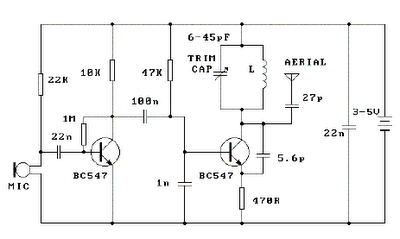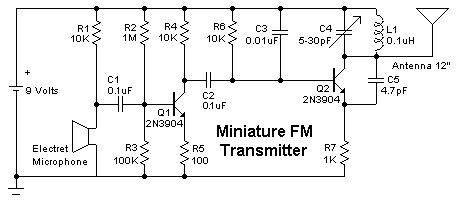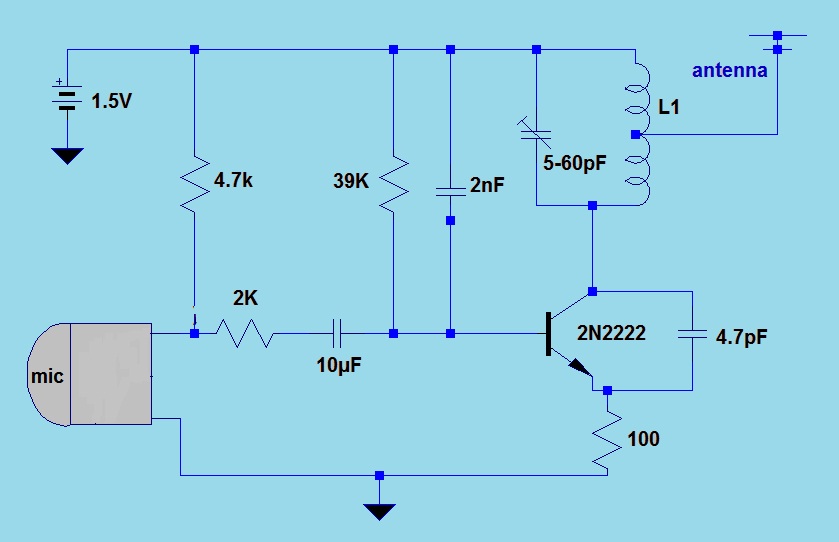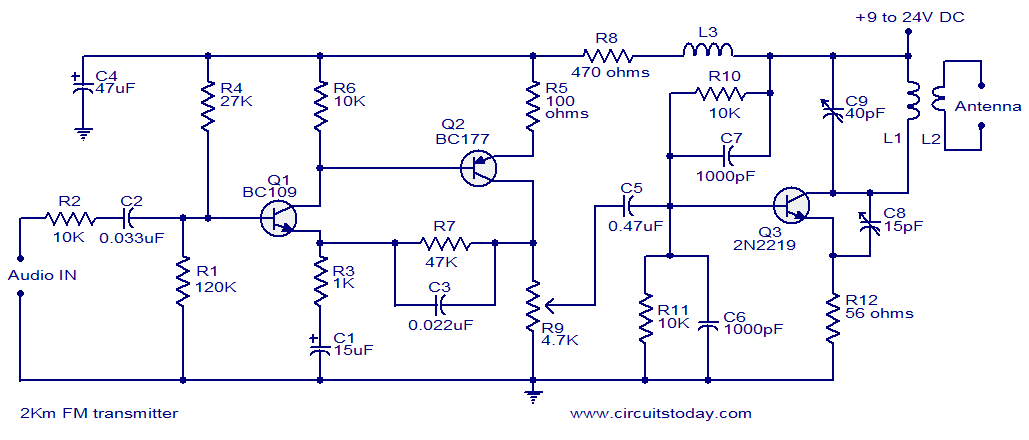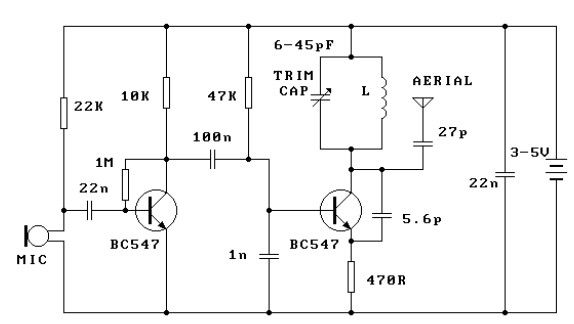
FM Transmitter with 2N2218
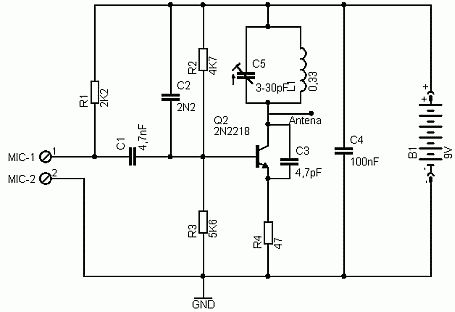
This is a simple FM transmitter circuit utilizing a medium power 2N2218 transistor. An electret type microphone is connected to two input terminals, and the antenna should be a copper wire measuring between 15 to 40 cm. Below is the schematic circuit of the FM transmitter.
The FM transmitter circuit operates by converting audio signals from the electret microphone into radio frequency signals. The 2N2218 transistor serves as the main amplification element in this circuit. The electret microphone picks up sound waves and converts them into electrical signals, which are then fed into the base of the transistor.
The circuit typically consists of a few key components: the electret microphone, the 2N2218 transistor, resistors, capacitors, and the antenna. The microphone is powered by a biasing resistor connected to a suitable voltage source, often a battery. The output from the microphone is coupled to the base of the transistor through a coupling capacitor, allowing only the AC audio signals to pass while blocking any DC components.
The transistor amplifies the audio signal, which is then modulated onto a carrier frequency. This modulation process allows the audio signal to be transmitted over radio waves. The output from the collector of the transistor is connected to the antenna, which radiates the modulated signal into the surrounding environment.
The length of the antenna plays a crucial role in determining the transmission range and quality of the signal. A copper wire antenna between 15 to 40 cm is typically used, as it is well-suited for the frequency range of the FM band. The choice of length can be adjusted based on the desired frequency of operation, with shorter lengths generally favoring higher frequencies.
Additional components may include capacitors for frequency stabilization and resistors for setting the biasing levels of the transistor. The overall design of the circuit is straightforward, making it suitable for hobbyists and educational purposes in understanding basic radio frequency transmission principles. Proper layout and component selection are essential to achieve optimal performance and minimize interference in the transmitted signal.Here`s simple FM transmitter circuit using medium power 2N2218 transistor. Micropohone is of electret type that connects to two input terminals and the antenna should be a copper wire from 15 to 40 cm. Below is schematic circuit of the fm transmitter.. 🔗 External reference
The FM transmitter circuit operates by converting audio signals from the electret microphone into radio frequency signals. The 2N2218 transistor serves as the main amplification element in this circuit. The electret microphone picks up sound waves and converts them into electrical signals, which are then fed into the base of the transistor.
The circuit typically consists of a few key components: the electret microphone, the 2N2218 transistor, resistors, capacitors, and the antenna. The microphone is powered by a biasing resistor connected to a suitable voltage source, often a battery. The output from the microphone is coupled to the base of the transistor through a coupling capacitor, allowing only the AC audio signals to pass while blocking any DC components.
The transistor amplifies the audio signal, which is then modulated onto a carrier frequency. This modulation process allows the audio signal to be transmitted over radio waves. The output from the collector of the transistor is connected to the antenna, which radiates the modulated signal into the surrounding environment.
The length of the antenna plays a crucial role in determining the transmission range and quality of the signal. A copper wire antenna between 15 to 40 cm is typically used, as it is well-suited for the frequency range of the FM band. The choice of length can be adjusted based on the desired frequency of operation, with shorter lengths generally favoring higher frequencies.
Additional components may include capacitors for frequency stabilization and resistors for setting the biasing levels of the transistor. The overall design of the circuit is straightforward, making it suitable for hobbyists and educational purposes in understanding basic radio frequency transmission principles. Proper layout and component selection are essential to achieve optimal performance and minimize interference in the transmitted signal.Here`s simple FM transmitter circuit using medium power 2N2218 transistor. Micropohone is of electret type that connects to two input terminals and the antenna should be a copper wire from 15 to 40 cm. Below is schematic circuit of the fm transmitter.. 🔗 External reference
